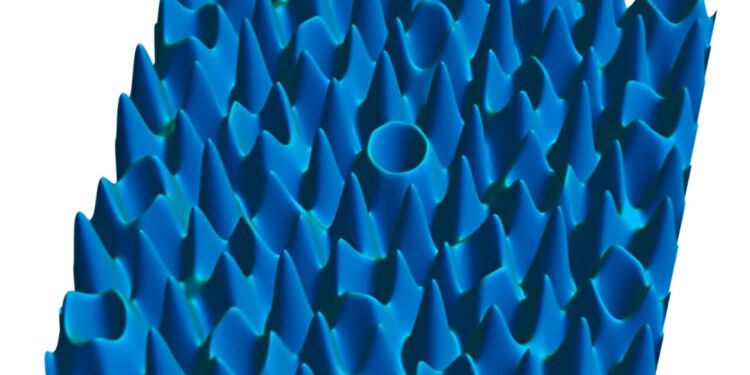The quasi-periodic landscape in which the new Bose glass forms, similar to a Penrose tiling. Credit: Many-Body Quantum Dynamics Laboratory / Cavendish Lab
Physicists at Cambridge’s Cavendish Laboratory have created the first two-dimensional version of Bose glass, a new phase of matter that defies statistical mechanics. Details of the study were published in Nature.
As the name suggests, Bose glass has vitreous properties and all particles are localized. This means that each particle in the system adheres to itself and does not mix with its neighbors. If coffee were localized, when milk was added to it, the intricate pattern of black and white stripes would remain forever, instead of fading to an average.
To create this new phase of matter, the group superimposed multiple laser beams to create a quasi-periodic pattern, a long-range ordered pattern like a classical crystal, but not periodic, meaning that, like a Penrose tiling, it never repeats. By filling the resulting structure with ultracold atoms, cooled to nanokelvin temperatures (near absolute zero), the atoms formed Bose glass.
“Localization is not only one of the most difficult problems in statistical mechanics, it can also help advance quantum computing,” said Professor Ulrich Schneider, professor of many-body physics at Cavendish Laboratory, who led the study. Since a localized system would not mix with its environment, quantum information stored in a localized system would be preserved much longer.
“One of the main limitations of large quantum systems is that they are impossible to model on a computer,” Schneider explains. “To accurately describe the system, we need to consider all its particles and all their possible configurations, a number that is growing very quickly. However, we now have a real 2D example that we can study directly and whose dynamics and statistics we can observe.”
Schneider and his team focus on research in quantum simulation and many-body quantum dynamics. They use ultracold atoms to study many-body effects that, in the absence of a large, complete quantum computer, cannot be simulated numerically.
Example of a Penrose tiling. Credit: Many-Body Quantum Dynamics Laboratory / Cavendish Lab
Very often this problem simplifies considerably because the system always relaxes into a thermal state in which only the temperature of the system is important and most other details disappear. This is called ergodic and is the basis of statistical mechanics, one of the pillars of our understanding of matter.
“For example, knowing the amount of milk poured is enough to predict the final color of our coffee after a long brewing,” Schneider explains. “However, if we want to predict the complete structure of the white and dark swirls during brewing, it is important to know where the milk was poured and how the brewing is done precisely.”
Interestingly, Bose glass does not appear to be ergodic. This means that it does not “forget its details,” and so its modeling will require all the details. This makes it a prime candidate for many-body localization.
“It is a long-term aspiration to find a system or material with many-body localization,” said Dr. Jr-Chiun Yu, first author of the study.
“Such a material would offer many new possibilities, not only for fundamental studies, but also for building quantum computers, because quantum information stored in such a system should remain more local and not leak into its environment – a process called ‘decoherence’ that affects many current quantum computing platforms.”
During the experiment, the researchers observed a surprisingly sharp phase transition between a Bose glass and a superfluid, similar to the way ice melts as the temperature increases.
“A superfluid is a fluid that flows without any resistance,” said Dr Bo Song, a former postdoctoral researcher at Cambridge and now an assistant professor at Peking University, who contributed to the research.
“Imagine particles swimming in a superfluid: there would be no friction and the fluid would not slow them down. This property, called superfluidity, is closely related to superconductivity. Together with another quantum phase, the Mott insulator, the recently observed Bose glass and the superfluid constitute the ground states of the Bose-Hubbard model that describes the physics of bosons in an interacting and disordered system.”
Bose glasses and superfluids are distinct phases of matter, like ice and liquid water. However, like ice cubes in a cup of water, atoms in their system can form both phases in the same experiment. The experimental results, confirming recent theoretical predictions, reveal how Bose glass forms and evolves, allowing scientists to begin thinking about its applications.
However, while the future offers exciting opportunities, Schneider believes we must exercise caution.
“There is still much we don’t understand about Bose glass and its potential connection to many-body localization, both in terms of its thermodynamics and its dynamical properties. We should first try to answer more questions before trying to find uses for it,” Schneider concludes.
More information:
Ulrich Schneider, Observation of two-dimensional Bose glass in an optical quasicrystal, Nature (2024). DOI: 10.1038/s41586-024-07875-2. www.nature.com/articles/s41586-024-07875-2
Provided by the University of Cambridge
Quote:Discovery of new phase of 2D matter defies normal statistical mechanics (2024, September 11) retrieved September 11, 2024 from
This document is subject to copyright. Apart from any fair dealing for the purpose of private study or research, no part may be reproduced without written permission. The content is provided for informational purposes only.



